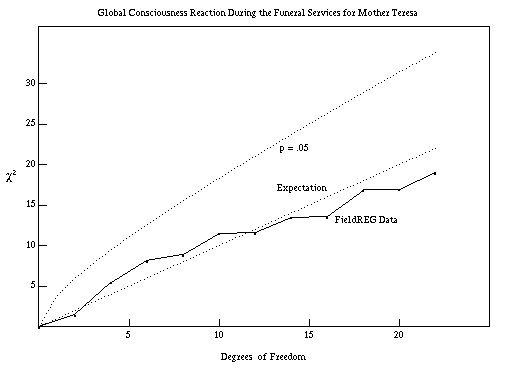| Global Resonance of Consciousness: Princess Diana and Mother Teresa |
| Roger Nelson,
Holger Boesch, Emil Boller, York Dobyns, Joop Houtkooper, Arnold Lettieri, Dean Radin,
Linda Russek, Gary Schwartz, Jerry Wesch Nelson, Dobyns, and Lettieri are from Princeton University, Princeton, New Jersey; Boesch and Boller are from the Institut fuer Grenzgebiete, Freiburg, Germany; Houtkooper is from the University of Giessen, Giessen, Germany; Radin is from the University of Nevada, Las Vegas, Nevada; Schwartz and Russek are from the University of Arizona, Tucson, Arizona; Wesch is from Health Psychology Consultation, Chicago, Illinois. The Electronic Journal of Parapsychology, eJAP . (1998) |
Abstract The tragic death of Princess Diana generated a worldwide reaction, and the memorial ceremonies focused attention from across the world in a shared consciousness experience with profound emotional impact. We hypothesized that the worldwide sharing might produce an effect on the random event generator (REG) devices used in Field REG studies. A week later, the world watched Mother Teresa's funeral, and, though her death generated a less emotional reaction, it was another opportunity to study possible anomalous effects of global events. Independent REG datasets were recorded before, during, and after
the public ceremonies of both funerals. Published official schedules were used to specify
analytical segments corresponding to well-defined parts attended by the public locally and
via worldwide live TV coverage. The raw data in Field REG experiments are recorded as a
continuous sequence of trials each consisting of a preset sample of binary events from a
truly random source. To quantify the hypothesized effect, deviations of the means of
experimental segments are compared with random expectation. A resampling process is used
to generate a control distribution by randomly drawing segments matching those of the
active data from the surrounding undesignated data. |
|
|
|
 Eleven datasets for Mother Teresa's funeral show little indication of an anomalous effect, with a composite outcome indistinguishable from chance (p = 0.654), as displayed in a similar graph. We speculate that the difference derives from the nature of the global attention, which was very different in the two cases. The significant result for Diana's funeral confirmed our prediction based on the obvious potential of this tragic and unexpected occasion to produce emotional engagement and resonance. The outcome is consonant with results obtained in previous Field REG studies and supports tentative interpretations suggesting that groups of people, especially when they are attuned and engaged by a common theme, may produce something like a "consciousness field" that can induce a small but statistically identifiable bias in a nominally random sequence. The shock and dismay over Diana's death galvanized an overwhelming reaction that was the preeminent media topic for several days. The funeral ceremonies occupied virtually all the major television channels and hence the attentions of an unprecedented number of people. This focus, and the entrainment of ideas and emotions it entailed, might be expected to produce a widespread resonance of affect. In contrast, Mother Teresa's death was expected, and she had lived a full and exemplary life, allowing her memory to be honored without the profound grief and dismay that was engendered by Princess Diana's death. These important differences in the two situations may explain the significantly different experimental results, and also link them with findings in psychological and sociological studies of personal loss. |
